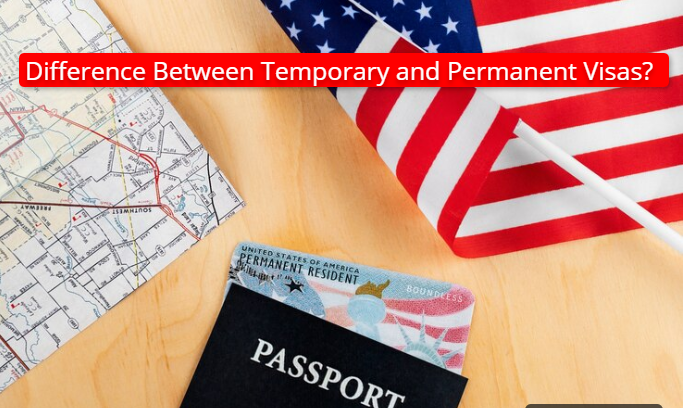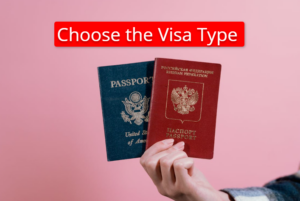What Is the Difference Between Temporary and Permanent Visas?

Navigating U.S. immigration requires understanding the differences between temporary and permanent visas. These two sections specify your legal status, rights, and duration of stay in the nation. We investigate both visa kinds, their types, application processes, and requirements in this extensive guide so that you have all the information required to decide with guidance.
What Is Temporary Residency?
What is the temporary residence? Temporary residency is government permission issued for a limited period and for a specified purpose allowing one to stay in a nation. Short-term goals that include visiting, working, or studying call for a temporary visa.
Key Characteristics of Temporary Residency
- Limited duration (six months, one year, or more).
- Purpose-specific (e.g., employment, education, travel).
- No natural pathway to citizenship or permanent residence.
Common reasons for seeking temporary residence USA are professional possibilities and education. In legal terms, temporary visa holders are not immigrants.
Examples of Temporary Visas
Here are typical temporary visas available in the United States:
-
Tourism or Business (B1/B2):
o For visiting family, attending business conferences, and traveling for leisure.
o For those on the vocational or academic course of study.
o For American companies’ employees in specialized sectors.
o For professional training or cultural exchange programs.
o For those with extraordinary artistic, scientific, or sporting ability.
What Is Permanent Residency?

Permanent residence means the legal right to live, work, and remain permanently in the United States. It is most usually connected with Green Card holders, who are regarded as lawful permanent residents.
Key Characteristics of Permanent Residency
- Indefinite duration with fewer restrictions.
- Broad employment opportunities.
- Access to social benefits after a qualifying period.
- Pathway to U.S. citizenship through naturalization.
Examples of Permanent Visas
Common categories of permanent visas include:
o For immediate relatives of U.S. citizens or Green Card holders.
o For skilled workers, professionals, or investors.
o For refugees or asylees.
-
Diversity Visa Lottery:
o For those from low-immigrant countries to the United States
Key Differences Between Temporary and Permanent Visas
Understanding the distinction between temporary and permanent visas can clarify your immigration options:
| Aspect | Temporary Residency | Permanent Residency |
| Duration | Limited (6 months to several years). | Indefinite. |
| Purpose | Short-term goals (e.g., work, study). | Long-term living and working. |
| Work Rights | Restricted to specific conditions. | Broad freedom to work anywhere. |
| Pathway to Citizenship | Rarely leads to citizenship. | A step toward naturalization. |
| Travel Rights | Limited to visa terms. | Easier re-entry into the U.S. |
Temporary Residency Application Procedure
The application process for temporary residents USA requires accurate planning:
Step 1: Choose the Visa Type

Determine the kind of visa you need—study (F1), employment (H1B), or tourism (B2).
Step 2: File the DS-160 Form
Complete your non-immigrant visa application online.
Step 3: Pay the Application Fee
Visa charges change based on the category.
Step 4: Schedule and Attend the Interview
Get ready for the required paperwork including :
- A passport
- Financial evidence covering costs.
- Proof of intention to go back home.
Permanent Residency Application Process
Step 1: Determine Eligibility
Your eligibility for permanent residence means will depend on your category—for example, family sponsorship or job.
Step 2: File the Immigrant Petition
- File Form I-130 for family-based visas
- File Form I-140 for employment-based visas.
Step 3: Adjust Status or Consular Processing
- If in the U.S.: File Form I-485 for Status Adjustment.
- If abroad: Under complete consular processes at a U.S. embassy or consulate.
Step 4: Medical Examination and Biometrics

Finish medical tests and submit biometric information for security reviews.
Step 5: Green Card Issuance
Once approved, you get a Green Card, therefore proving you to be a lawful temporary resident moving to permanent status.
Transitioning from Temporary to Permanent Residency
Many temporary visa holders have as their common goal becoming permanent residents. Usually called green card temporary to permanent, this process entails:
-
Maintaining Legal Status:
o Make sure your temporary visa is still valid.
-
Employer Sponsorship:
o Your company might apply for a Green Card grounded in employment.
-
Family Sponsorship:

o Immediate relatives can sponsor your application.
-
Marrying a U.S. Citizen:
o Spouses of citizens can directly seek permanent residency.
Legal Rights and Responsibilities of Temporary and Permanent Residents
Rights of Temporary Residents
Depending on their visa, temporary residents possess particular rights:
- Work Authorisation: Restricted for others like B2 (tourist visas), but approved for work visas, such as H1B.
- Study Rights: Approved for those holding F1 visas and having access to American colleges.
- Limited Social Benefits: Usually temporary residents are not eligible for government help programs.
Rights of Permanent Residents
- Employment Flexibility: Permanent residents can work with any company free from sponsorship restrictions.
- Travel and Re-entry: Green Card holders have fewer limitations when traveling abroad.
- Social Benefits Access: Meeting residence requirements qualifies individuals for programs including Medicare, Social Security, and unemployment benefits.
Responsibilities of Both Temporary and Permanent Residents
- Admire all American laws.
- File American taxes, if relevant.
- Update your address and notify U.S. Citizenship and Immigration Services (USCIS).
Temporary vs. Permanent: Which is Right for You?
When choosing between a temporary or permanent visa, consider these elements:
-
Purpose:
While permanent residency is appropriate for long-term settlement, temporary visas are best for short-term needs such as employment or study.
-
Duration:

While permanent residency permits indefinite stay, temporary visas have set timelines.
-
Eligibility:
Find out whether you fit the criteria for permanent residence. If not, start with a temporary visa and investigate eventual change of course possibilities.
Challenges Faced by Temporary and Permanent Visa Holders
Challenges for Temporary Residents
-
Visa Expiry:
One of the temporary visas is time-sensitive. Overstaying might result in future visa denial or deportation.
-
Limited Rights:
Restrictions on employment, travel, and access to some services could be placed on temporary residents.
-
Adjustment to Permanent Residency:
Not all temporary visas provide a route to Green Cards, thus long-term plans are left in doubt regarding adjustment to permanent residency.
Challenges for Permanent Residents
-
Maintaining Status:
Extended absences from the United States could compromise residency. To maintain their status, permanent citizens have to keep links to the United States.
-
Naturalization Requirements:
Permanent residents seeking citizenship have to meet residency, language, and civics test standards.
-
Legal Obligations:
Failure to comply with tax obligations or criminal laws may result in deportation.
Tips for Long-Term Success in the U.S. Immigration System

-
Maintain Accurate Documentation:
Make sure all of your records—including financial accounts, passports, and visa approvals—are updated and available.
-
Work with an Immigration Attorney:
Working with an immigration attorney guarantees better results for complicated matters.
-
Stay Informed:
The laws and regulations related to immigration change frequently. Maintaining up-to-date facilitates effective navigation.
-
Build a Strong Application:
Including thorough documentation to back up your case—such as proof of intent to return for temporary visas or financial stability for Green Card applications—will strengthen your application.
The Role of USCIS in Temporary and Permanent Residency
Processing applications for both temporary and permanent visas is mostly the responsibility of United States Citizenship and Immigration Services (USCIS). The following need to be known by candidates:
-
Processing Times:
o Even though temporary visas have shorter processing times, temporary visas sometimes call for renewals.
o The category will determine whether permanent residency applications take months to years.
-
Approval Rates:

o Approval rates rely on proper documentation, fulfilling eligibility criteria, and avoidance of typical mistakes.
-
RFEs (Requests for Evidence):
USCIS generates an RFE if further proof is required. Approval depends on a quick and thorough response.
Final Thoughts
Your goals, eligibility, and situation will determine whether either temporary or permanent visas best fit you. While permanent residency is good for those wishing long-term residence in the United States, temporary visas are appropriate for short-term goals including study or employment.
CTA: Start Your Immigration Path with Passage Law
Navigating U.S. immigration can be difficult, at Passage Immigration Law, we provide professional advice specifically for your circumstances. Our professional lawyers are always here to help you at every stage.
